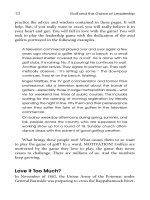Tài liệu Golf and the game of leadership 19 docx
Bạn đang xem bản rút gọn của tài liệu. Xem và tải ngay bản đầy đủ của tài liệu tại đây (199.37 KB, 10 trang )
170
Golf and the Game of Leadership
is needed. It also tells people someone cares how they are doing
and that what they do is important.
By the Numbers
The management of a large manufacturing unit was concerned
about increasing production and quality problems. They deter-
mined that the cause was a high level of both tardiness and absen-
teeism. Supervisory efforts to get people to show up for work were
largely ineffective. Punishing tardy employees caused them to not
come to work at all if they were going to be late. They would
rather turn around and go home than be punished.
A young supervisor, recently returned from ‘‘charm school’’
(a leadership class), asked his boss if he could try using a basic
feedback technique he had learned in class to reduce the absences.
The boss said yes, with the usual caveat, you can’t spend any
money.
The supervisor obtained some large sheets of chart paper. He
began to write two numbers on a chart taped to a support column
in his department. Each day the numbers changed. He said noth-
ing to the employees about the chart.
After a few days, an employee asked what the numbers meant.
The supervisor told him that one was the number of good parts
produced in the department the previous day and the other the
number of employees who showed up on time that day.
Word about what the numbers meant soon got around the
department. Employees were seen checking the chart. One em-
ployee observed, ‘‘Look, when more people are on time for work
our production and quality numbers go up.’’ Soon it became a
game for the employees. They encouraged one another to be on
time so they could see if they could continue to make the produc-
tion and quality numbers go up.
In a few weeks, employees in the next department asked to
post their information. Soon all the departments had posted their
performance feedback charts and enjoyed competing with each
other to see who could perform the best.
The young supervisor had removed the ‘‘curtain across the
10589$ CH14 02-23-04 16:45:26 PS
171
Provide Constructive Feedback
bowling alley.’’ The employees were now able to measure their
performance. They saw themselves as full participants in the game
and it resulted in improved performance.
Receiving the Perfect Gift: Constructive
Feedback
The employees in the above example responded very positively
to being given simple feedback. In other situations, the feedback
process can be much more involved. Here are some thoughts re-
garding how to receive feedback for ‘‘you’’ (yes, in both your roles
on this alternate play hole):
1. Adopt the mindset that you have something to learn from
the feedback.
2. Relax, take a deep breath, try to think clearly.
3. Listen. Make sure you understand the feedback. Determine
exactly what is being communicated to you. Ask for clari-
fication if needed.
4. Do not respond if you feel reactive or defensive. Offer to
get back together for discussion later. (This is very impor-
tant. Don’t jump into discussion if you are not calm, cool,
and collected.)
5. Do respond in a way that communicates respect and admi-
ration for the person who is giving you the gift of construc-
tive feedback. Join with the other person in a discussion
as to how the feedback can cause you to improve your
performance.
Who Helps Leaders?
Skilled golf coaches, such as Butch Harmon and David Leadbetter,
are able to help professional and amateur golfers through observa-
tion, feedback, and specific suggestions. The golfer must then
translate the suggestions into action. This is the process of ‘‘con-
tinuous improvement’’ that drives all avid golfers. Unfortunately,
10589$ CH14 02-23-04 16:45:26 PS
172
Golf and the Game of Leadership
though untold amounts of time and money are spent in business,
industry, education, health care, and government on the continu-
ous improvement of processes, comparatively little emphasis is
placed on the continuous improvement of the leaders of the peo-
ple on the front line.
Who helps leaders in today’s organizations identify their fun-
damental leadership skill deficiencies? Sadly, there is not much
help available beyond descriptions of leadership style and/or per-
sonality. These are nice to know, or to have confirmed, and they
can be helpful. However, they are not a substitute for leadership
effectiveness feedback, which identifies how leaders are doing as
perceived by those whom they impact as leaders.
Performance evaluation, or performance appraisal, is adver-
tised in most organizations as an annual process designed among
other things as the tool for leadership effectiveness measurement.
This annual ‘‘feedback requirement’’ is not viewed as productive
by most employees and is a dreaded Human Resource Depart-
ment obligation forced on supervisors and managers, who for the
most part are ill prepared to do it and thus do it poorly. When it
is done well it involves a leader/follower relationship that has been
built on a day-to-day, situation-to-situation constructive feedback
relationship, and which requires no more than a summary review
at the time of the mandatory evaluation. In other words, the proc-
ess should be a natural part of the way in which we successfully
lead the organization.
A golfer hits a bad shot. The ball goes into the trees, in the
water, out of bounds; the ball is topped and goes nowhere; or the
ball is missed entirely, an embarrassing ‘‘whiff.’’ The golfer’s play-
ing partners do not applaud, congratulate or say ‘‘that was a good
shot.’’ In the case of a ‘‘whiff’’, the ‘‘Tuesday Group’s’’ mem-
bers—gentlemen through and through—have been known to
comment on the quality of their partner’s practice swing! But
that’s the exception, golfers do not reward poor play. They don’t
demean it. They are just quiet about it. You struggle on your own.
If you ask for help, they’ll give it if they can. In the end, poor play
is not overlooked. Your scorecard will tell the story. This golfing
etiquette of not giving another golfer advice unless it is requested
10589$ CH14 02-23-04 16:45:26 PS
173
Provide Constructive Feedback
also applies to our giving feedback to peers and volunteers. The
first step in such situations should be to consider whether the
other person would like some feedback
What Is Your Leadership Score?
In organization life, poor leadership play is in my experience too
often overlooked. People are told they are doing okay when they
are not. We either don’t like to deliver constructive feedback,
don’t understand our responsibility to the organization and its
hard-working, contributing members, or are more concerned
about someone’s self-esteem than their job performance. Yet it is
their job performance for which they are paid. Then one day we
are faced with the person who has the security of twenty years on
the job and literally refuses to meet our performance expectations.
Why not?! He or she has been taught that mediocre performance
is acceptable. And the organization develops the ‘‘M’’—for medi-
ocrity—disease.
What is needed is the application of the concept of ‘‘perform-
ance improvement for everyone’’ to the leadership development
process in organizations. What needs to be done is to brush away
the fuzz, the fluff, the political correctness, the ‘‘get a powerful
mentor’’ behavior, etc., and get down to basics. Everyone should
have a ‘‘Performance Improvement Plan’’ with clearly established
performance expectations, which are used to determine whether
the plan is being met. This will require regularly scheduled reviews
and the opportunity for unscheduled reviews as necessary. It will
require leaders to be coaches—what should be, but rarely is, their
number one priority. It will provide the genuine gift of construc-
tive feedback to organizational members. It will model the power
of constructive feedback present in the game of golf and enhance
the opportunity to significantly improve the effectiveness of orga-
nizational leadership just as application of feedback in the game
of golf can lead to lower scores.
When the golfer strikes the golf ball, and a ‘‘slice’’ or a ‘‘hook’’
or ‘‘straight down the middle’’ follows, the result is clearly observ-
able and measurable. When a follower knows what is expected,
10589$ CH14 02-23-04 16:45:27 PS
174
Golf and the Game of Leadership
knows what the measurements are, and acts, the results will also
be clearly observable and measurable. Timely, honest, specific,
and constructive feedback is the ‘‘perfect gift for the aspiring
leader.’’ You can’t hold a ‘‘slight edge’’ without it.
Which one of ‘‘you’’—leader or follower—contributed the
best shots on our ‘‘alternate shot’’ hole? What strengths did you
observe? What areas did you identify for improving the giving and
receiving of constructive feedback?
The next two holes, ࠻15 and ࠻16, will continue to build on
how we can become better, more effective leaders and at the same
time help our people maximize their ability to perform.
Leaders who are strong ask for help. Leaders who give
more receive more.
2
Dr. Edward Dwyer
Quick Tips for Improving Your Leadership
Game
Real leaders typically understand and model the following in their
day-to-day actions:
■
Establish a climate wherein your ideas can be questioned
or challenged by all your associates.
■
Give positive feedback before giving negative feedback.
Recognition of accomplishments makes the need for im-
provement easier to accept.
■
NEVER, NEVER ‘‘kill the messenger.’’
10589$ CH14 02-23-04 16:45:27 PS
5
15
Accept Change: Adapt
I love golf. Every day’s a different day. Every shot’sa
different shot.
Greg Norman, CBS 60 Minutes, April 6, 1997
The game of golf is hundreds of years old. The game of leadership
is older. Both have changed considerably over the centuries. Yet
their essential elements remain.
Throughout history there have been games played with a ball
and a club, or reasonable facsimiles thereof. The golf ball has
changed considerably over time. The ‘‘feathery,’’ followed by the
‘‘rubber guttie,’’ then the ‘‘rubber core,’’ and now a choice of two-
or three-piece balls with solid or soft centers, have been the major
developments. Clubs also have changed. Shafts were made of
wood, usually hickory, for years. The first seamless steel shafts
were introduced in 1912, the first metal-headed driver in the
1890s. These innovations were followed by matched sets of clubs.
Now we have graphite shafts and space-age titanium club heads.
175
10589$ CH15 02-23-04 16:45:33 PS
176
Golf and the Game of Leadership
Improvements in golf equipment have made it easier for millions
to play the game.
The leadership game has also changed over centuries. The in-
dustrial revolution, the great depression, two world wars, space
and information technology, and social change have caused orga-
nizational restructuring in the drive to compete. Organizations
still have hierarchies but also networks, autocratic leadership is
giving way to inspirational approaches, homogeneous work forces
are now culturally diverse, domestic markets have expanded to
global markets, work done by individuals is now assigned to
teams, and so on. These changes have greatly affected the way
leaders are able to play the leadership game.
The leader’s challenge is not unlike what the golfer faces in
playing on a new, and therefore unfamiliar, golf course. The golfer
must adapt to the new course requirements in order to be success-
ful. The leader will continue to see changes in the leadership
course and must be able to adapt if leadership effectiveness is to
be maintained.
Adapt Now: Improve for the Future
A firm that manufactured large generating systems devised a supe-
rior diesel engine. It revolutionized the industry and captured
most of the market. The company devoted all its resources to the
production and sale of the engine. It was so efficient and reliable
and had such wide customer acceptance that they sold all they
could produce. This success continued for nearly twenty years.
Finally, and inevitably, a competitor developed a superior en-
gine. They began to take market share away from the industry
leader, who responded by commissioning its engineering depart-
ment to develop a new engine. They got no results. Their engi-
neers did not have the experience or capability to design and
develop a new engine. After all, they had the world’s best engine
and had never given thought to having to design a better one.
They could not adapt to their new circumstances!
The firm’s solution was to improve their engineering staff’s
10589$ CH15 02-23-04 16:45:33 PS
177
Accept Change: Adapt
capability for the future. The engineering planning process was
adapted to include initiating a new engine design and develop-
ment project every five years. These projects were not focused on
the need for a new engine but on the need to improve the capabil-
ity to design one. The company went back to the basics, as we
discussed on hole ࠻6. Management focused on the situation: The
issue of ‘‘engineering staff capability’’ was placed front and center.
The necessary steps were taken to build a competitive design and
development group. Poorly focused leadership had gotten them
in trouble. Properly focused leadership was going to get them back
on track.
No Prize for Coming in Second
An office-supply company periodically ran sales contests to ‘‘mo-
tivate’’ its salespeople. The same two people consistently won the
contests and took home the prizes. Company management even-
tually recognized that the rest of the sales force did little better
during the contests than they did in normal circumstances. Man-
agement’s assessment was that ‘‘those people just aren’t moti-
vated.’’
The nonwinners, when asked, said they gave up competing
because they knew they couldn’t beat the two staff superstars,
‘‘there are no rewards for second place.’’
The inevitable management consultant was called in to look
at the ‘‘motivation’’ problem. After some discussion and analysis,
the consultant suggested some changes in the scoring of the con-
tests. In addition to overall winners, awards should go to those
who improved their individual performance numbers by the high-
est percentage. In that way, the salespeople would be competing
against themselves (just like in golf) and not against the super-
stars.
The adaptation of the contest rules resulted in staff members
significantly improving their individual productivity. They were
challenged in a positive way. The organization experienced a fu-
ture of increased sales.
10589$ CH15 02-23-04 16:45:34 PS
178
Golf and the Game of Leadership
Some Adapt, Some Don’t
There seem to be some consistent differences between the results
of first and second shift operations in production facilities. The
second shift tends to out-perform the first. The second shift per-
sonnel are usually younger and have fewer years of service than
the first.
For example, the second shift of a warehousing operation de-
veloped a new way to feed large parts down the line. They replaced
an expensive method of operating a conveyor belt with a simple
gravity feed system. Management was pleased with this continu-
ous improvement effort by the workers and presented the idea to
the first shift crew. The people on days wouldn’t buy the idea. It
wasn’t theirs—a good example of the ‘‘not invented here’’ syn-
drome. They were not going to adapt.
So, the conveyor belt ran on the first shift and, after the mill-
wrights took a half-hour to change it, the gravity feed system ran
on the second. This continued for six months until management
went ahead and instituted the gravity feed for both shifts. Thus a
good idea developed by a group of workers to improve operations
was delayed from full implementation for six months because an-
other group of workers and a less than forceful management team
refused to adapt to the change.
The late Dr. Norman R. F. Maier, professor of psychology
for many years at the University of Michigan, taught his quality/
acceptance theory of decision making at the university and as an
international consultant to numerous organizations. His theory,
in summary, holds that a decision consists of two parts: quality
and acceptance. Quality refers to the objective value of the deci-
sion, i.e., is it substantively the best choice. Acceptance refers to
the willingness of those affected by the decision to accept it. Obvi-
ously the best match is high quality and high acceptance. The
second shift operation made their decision based on the high
quality and high acceptance of the ‘‘gravity feed system over the
conveyor belt’’ in our example. When the high quality decision
was met by the low acceptance of the first shift, the change was
not accepted.
10589$ CH15 02-23-04 16:45:34 PS
179
Accept Change: Adapt
The other decision option involves low quality and high ac-
ceptance. This is the option the first shift decided upon and con-
tinued with until many months later when the ‘‘gravity feed
system’’ was put in place on both shifts. The example illustrates
Dr. Maier’s point concerning the importance of both acceptance
and quality in the decision-making process, and their impact on
implementation of a decision. Acceptance by those affected can
overcome some deficiencies in quality, but quality will not over-
come deficiencies in acceptance. This is an important concept for
the leader to remember, and consider, especially when attempting
to implement organizational change.
What? Me, Adapt?!
Groups and teams have difficulty accepting and adapting to
change. Individuals also have a hard time doing what the outsider
looking in sees as the obvious action. A greenskeeper once told
me what he called his favorite golf story. He actually saw this
happen.
A foursome teed off on a 420-yard par-four, dogleg left,
with water bordering the dogleg. The hole had just been
lengthened from its former 395-yard length by moving the
tee back. You could play the fairway, or if confident of a
200-yard drive in the air, go over the water to cut the dog-
leg for an easy second shot. That was before the tee
change; now it was at least 220 yards to cross the water.
The first three players hit their drives comfortably down the
fairway. The fourth, let’s call him Charlie, lined up to cut the
dogleg. It’s the way he had always played this hole. His tee
shot landed in the water ten yards short of the fairway.
His partners assumed Charlie would take a drop at the
point at which his ball began to cross the water. Not so,
apparently undaunted Charlie teed up another ball and
with a mighty swing launched the ball once again over the
water. Splash! Now certain he would take a drop, his part-
10589$ CH15 02-23-04 16:45:35 PS









